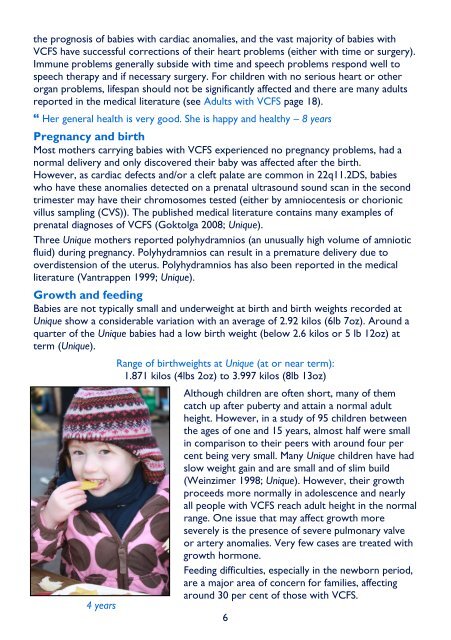Velo-Cardio- Facial Syndrome - Unique - The Rare Chromosome ...
Velo-Cardio- Facial Syndrome - Unique - The Rare Chromosome ...
Velo-Cardio- Facial Syndrome - Unique - The Rare Chromosome ...
Create successful ePaper yourself
Turn your PDF publications into a flip-book with our unique Google optimized e-Paper software.
the prognosis of babies with cardiac anomalies, and the vast majority of babies with<br />
VCFS have successful corrections of their heart problems (either with time or surgery).<br />
Immune problems generally subside with time and speech problems respond well to<br />
speech therapy and if necessary surgery. For children with no serious heart or other<br />
organ problems, lifespan should not be significantly affected and there are many adults<br />
reported in the medical literature (see Adults with VCFS page 18).<br />
Her general health is very good. She is happy and healthy – 8 years<br />
Pregnancy and birth<br />
Most mothers carrying babies with VCFS experienced no pregnancy problems, had a<br />
normal delivery and only discovered their baby was affected after the birth.<br />
However, as cardiac defects and/or a cleft palate are common in 22q11.2DS, babies<br />
who have these anomalies detected on a prenatal ultrasound sound scan in the second<br />
trimester may have their chromosomes tested (either by amniocentesis or chorionic<br />
villus sampling (CVS)). <strong>The</strong> published medical literature contains many examples of<br />
prenatal diagnoses of VCFS (Goktolga 2008; <strong>Unique</strong>).<br />
Three <strong>Unique</strong> mothers reported polyhydramnios (an unusually high volume of amniotic<br />
fluid) during pregnancy. Polyhydramnios can result in a premature delivery due to<br />
overdistension of the uterus. Polyhydramnios has also been reported in the medical<br />
literature (Vantrappen 1999; <strong>Unique</strong>).<br />
Growth and feeding<br />
Babies are not typically small and underweight at birth and birth weights recorded at<br />
<strong>Unique</strong> show a considerable variation with an average of 2.92 kilos (6lb 7oz). Around a<br />
quarter of the <strong>Unique</strong> babies had a low birth weight (below 2.6 kilos or 5 lb 12oz) at<br />
term (<strong>Unique</strong>).<br />
4 years<br />
Range of birthweights at <strong>Unique</strong> (at or near term):<br />
1.871 kilos (4lbs 2oz) to 3.997 kilos (8lb 13oz)<br />
Although children are often short, many of them<br />
catch up after puberty and attain a normal adult<br />
height. However, in a study of 95 children between<br />
the ages of one and 15 years, almost half were small<br />
in comparison to their peers with around four per<br />
cent being very small. Many <strong>Unique</strong> children have had<br />
slow weight gain and are small and of slim build<br />
(Weinzimer 1998; <strong>Unique</strong>). However, their growth<br />
proceeds more normally in adolescence and nearly<br />
all people with VCFS reach adult height in the normal<br />
range. One issue that may affect growth more<br />
severely is the presence of severe pulmonary valve<br />
or artery anomalies. Very few cases are treated with<br />
growth hormone.<br />
Feeding difficulties, especially in the newborn period,<br />
are a major area of concern for families, affecting<br />
around 30 per cent of those with VCFS.<br />
6

















